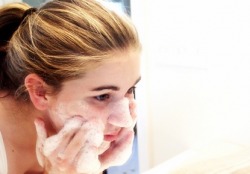Self care tips

Self Care do-it-yourself by better health news
What your nails say about your health
Our fingernails and toenails can serve as windows on your physical well being. Little white spots, for instance, can result from a low-grade illness at the time the nail was emerging. These flecks are harmless. Other abnormalities can indicate recent drug treatment or surgery. Certain discolorations and deformities may signal a serious underlying disease. Consult our chart to find out what your nails may be trying to tell you.
Yellow colour
Lung illnesses (tuberculosis asthma), fungal infections
Whitish colour
Chronic hepatitis or cirrhosis
Pale colour
Anemia
Bluish colour
Exposure to excess copper or silver, heart failure, chronic lung disorder
Gray, blue or brown colour
Too much iron (hemochromatosis)
Half-and-half nails(half normal colour, half white, horizontally)
Kidney disease
Horizontal white lines(Beau-reil lines)
Chemotherapy(nails grow slowly or stop growing briefly during treatment), drug reaction while the nail is forming, infectious diseases, recent surgery
Brittle, split
Dehydration
Small, black, splinter-like areas under the nails(actually small hemorrhages)
Infection of the heart valves (a symptom of bacterial endocarditis), lupus, trichinosis(an illness caused by eating certain infected, undercooked meats)
Extremely rounded(clubbed)
Congenital heart disease, lung cancer, other chronic heart or lung conditions, tuberculosis
Symptom finder rheumatoid arthritis
RED FLAGS:-
If symptoms persist for more than six weeks, see your doctor for a test to measure the amount of a protein called a rheumatoid and X-rays to examine your bone structure. If he diagnoses rheumatoid arthritis (a condition three times more common in women that in men)he’ll prescribe a strong dose of ibuprofen or a combination of physical therapy and medication. Many doctors favour more aggressive treatment the”wait and see”approach to prevent bone loss
The laughing workout
Realizing the physical and psychological importance of laughter, exercise classes abroad have started incorporating laughing practice into their workout routines. Here is what you do:
1) To strengthen the laughing muscles of the upper torso, sit cross-legged on the floor, arms comfortably at your sides. Raise arms out to the sides, palms out, shoulders relaxed.
2) Inhale, then hold your breath as you start to curl arms inward(like giving a big bear hug),resisting as you hug, hands slowly forming fists as they reach and touch the chest.
3) As you pull your arms in, scrunch up your face into a miserable grimace and growl as if you’ve had a really bad day. Exhale powerfully and lower arms. Repeat three or more times, depending on your stress level.
4) Resting hands in lap, rock back and forth and start laughing. Let out some heh-heh-hehs till your gut kicks in and arms and produce peals of radiant laughter. Just think about the last thing that really cracked you up.
What your nails say about your health
Our fingernails and toenails can serve as windows on your physical well being. Little white spots, for instance, can result from a low-grade illness at the time the nail was emerging. These flecks are harmless. Other abnormalities can indicate recent drug treatment or surgery. Certain discolorations and deformities may signal a serious underlying disease. Consult our chart to find out what your nails may be trying to tell you.
Yellow colour
Lung illnesses (tuberculosis asthma), fungal infections
Whitish colour
Chronic hepatitis or cirrhosis
Pale colour
Anemia
Bluish colour
Exposure to excess copper or silver, heart failure, chronic lung disorder
Gray, blue or brown colour
Too much iron (hemochromatosis)
Half-and-half nails(half normal colour, half white, horizontally)
Kidney disease
Horizontal white lines(Beau-reil lines)
Chemotherapy(nails grow slowly or stop growing briefly during treatment), drug reaction while the nail is forming, infectious diseases, recent surgery
Brittle, split
Dehydration
Small, black, splinter-like areas under the nails(actually small hemorrhages)
Infection of the heart valves (a symptom of bacterial endocarditis), lupus, trichinosis(an illness caused by eating certain infected, undercooked meats)
Extremely rounded(clubbed)
Congenital heart disease, lung cancer, other chronic heart or lung conditions, tuberculosis
Symptom finder rheumatoid arthritis
RED FLAGS:-
- Pain and swelling in more than one joint
- Nodules under the skin (usually near the elbows)
- Morning stiffness
- Fatigue
If symptoms persist for more than six weeks, see your doctor for a test to measure the amount of a protein called a rheumatoid and X-rays to examine your bone structure. If he diagnoses rheumatoid arthritis (a condition three times more common in women that in men)he’ll prescribe a strong dose of ibuprofen or a combination of physical therapy and medication. Many doctors favour more aggressive treatment the”wait and see”approach to prevent bone loss
The laughing workout
Realizing the physical and psychological importance of laughter, exercise classes abroad have started incorporating laughing practice into their workout routines. Here is what you do:
1) To strengthen the laughing muscles of the upper torso, sit cross-legged on the floor, arms comfortably at your sides. Raise arms out to the sides, palms out, shoulders relaxed.
2) Inhale, then hold your breath as you start to curl arms inward(like giving a big bear hug),resisting as you hug, hands slowly forming fists as they reach and touch the chest.
3) As you pull your arms in, scrunch up your face into a miserable grimace and growl as if you’ve had a really bad day. Exhale powerfully and lower arms. Repeat three or more times, depending on your stress level.
4) Resting hands in lap, rock back and forth and start laughing. Let out some heh-heh-hehs till your gut kicks in and arms and produce peals of radiant laughter. Just think about the last thing that really cracked you up.
